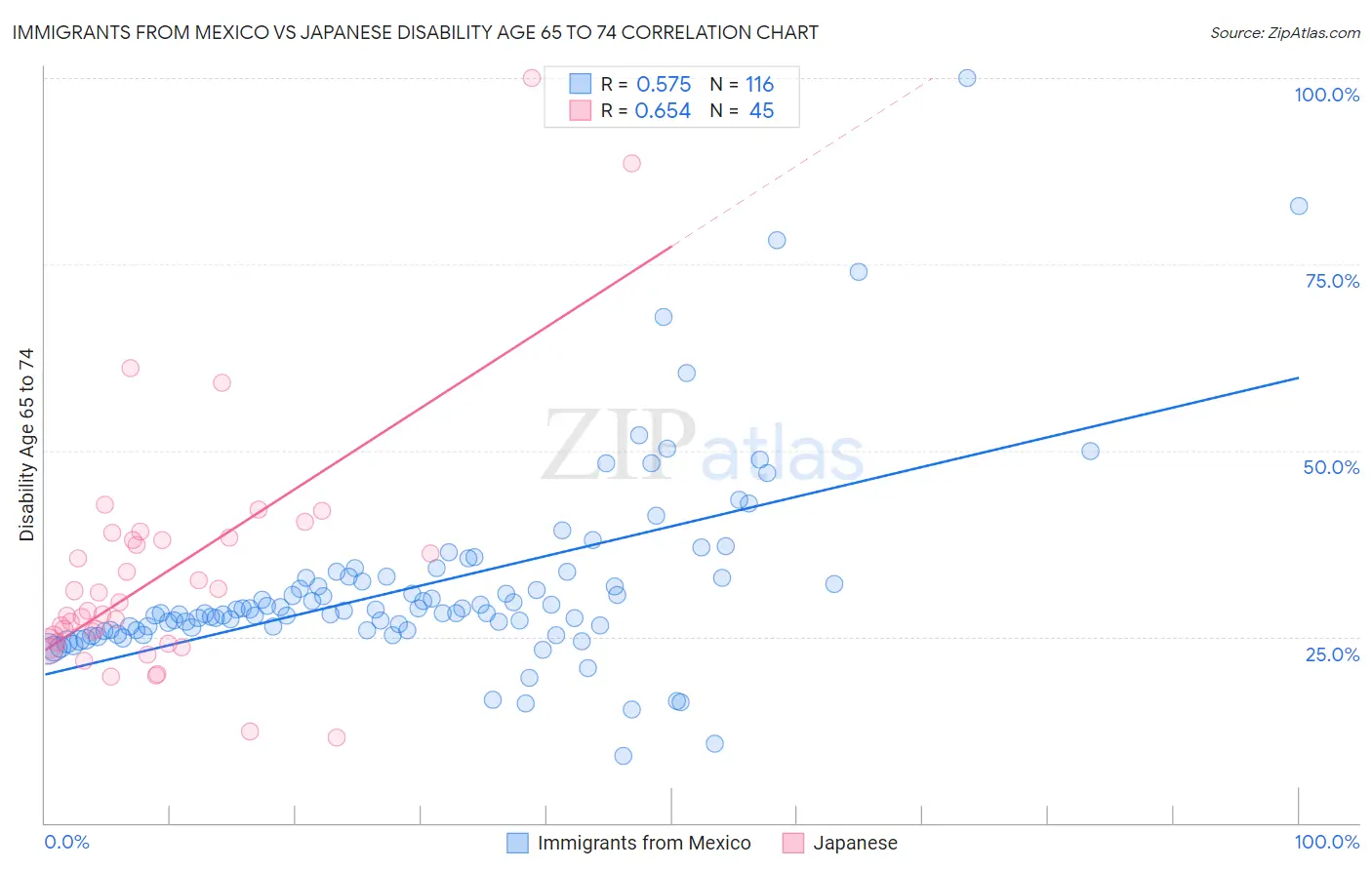Immigrants from Mexico vs Japanese Disability Age 65 to 74
COMPARE
Immigrants from Mexico
Japanese
Disability Age 65 to 74
Disability Age 65 to 74 Comparison
Immigrants from Mexico
Japanese
27.1%
DISABILITY AGE 65 TO 74
0.0/ 100
METRIC RATING
301st/ 347
METRIC RANK
25.7%
DISABILITY AGE 65 TO 74
0.1/ 100
METRIC RATING
273rd/ 347
METRIC RANK
Immigrants from Mexico vs Japanese Disability Age 65 to 74 Correlation Chart
The statistical analysis conducted on geographies consisting of 512,183,481 people shows a substantial positive correlation between the proportion of Immigrants from Mexico and percentage of population with a disability between the ages 65 and 75 in the United States with a correlation coefficient (R) of 0.575 and weighted average of 27.1%. Similarly, the statistical analysis conducted on geographies consisting of 248,828,802 people shows a significant positive correlation between the proportion of Japanese and percentage of population with a disability between the ages 65 and 75 in the United States with a correlation coefficient (R) of 0.654 and weighted average of 25.7%, a difference of 5.4%.

Disability Age 65 to 74 Correlation Summary
| Measurement | Immigrants from Mexico | Japanese |
| Minimum | 9.1% | 11.5% |
| Maximum | 100.0% | 100.0% |
| Range | 90.9% | 88.5% |
| Mean | 31.9% | 33.5% |
| Median | 28.4% | 28.5% |
| Interquartile 25% (IQ1) | 25.9% | 24.2% |
| Interquartile 75% (IQ3) | 33.0% | 38.1% |
| Interquartile Range (IQR) | 7.1% | 13.9% |
| Standard Deviation (Sample) | 13.3% | 16.5% |
| Standard Deviation (Population) | 13.2% | 16.4% |
Similar Demographics by Disability Age 65 to 74
Demographics Similar to Immigrants from Mexico by Disability Age 65 to 74
In terms of disability age 65 to 74, the demographic groups most similar to Immigrants from Mexico are Central American Indian (27.1%, a difference of 0.010%), Tlingit-Haida (27.1%, a difference of 0.070%), Puget Sound Salish (27.2%, a difference of 0.19%), Mexican (27.2%, a difference of 0.29%), and Immigrants from Dominican Republic (27.0%, a difference of 0.32%).
| Demographics | Rating | Rank | Disability Age 65 to 74 |
| Dominicans | 0.0 /100 | #294 | Tragic 26.7% |
| Hispanics or Latinos | 0.0 /100 | #295 | Tragic 26.7% |
| Bangladeshis | 0.0 /100 | #296 | Tragic 26.8% |
| Fijians | 0.0 /100 | #297 | Tragic 27.0% |
| Immigrants | Yemen | 0.0 /100 | #298 | Tragic 27.0% |
| Potawatomi | 0.0 /100 | #299 | Tragic 27.0% |
| Immigrants | Dominican Republic | 0.0 /100 | #300 | Tragic 27.0% |
| Immigrants | Mexico | 0.0 /100 | #301 | Tragic 27.1% |
| Central American Indians | 0.0 /100 | #302 | Tragic 27.1% |
| Tlingit-Haida | 0.0 /100 | #303 | Tragic 27.1% |
| Puget Sound Salish | 0.0 /100 | #304 | Tragic 27.2% |
| Mexicans | 0.0 /100 | #305 | Tragic 27.2% |
| Blacks/African Americans | 0.0 /100 | #306 | Tragic 27.3% |
| Ute | 0.0 /100 | #307 | Tragic 27.3% |
| Sioux | 0.0 /100 | #308 | Tragic 27.3% |
Demographics Similar to Japanese by Disability Age 65 to 74
In terms of disability age 65 to 74, the demographic groups most similar to Japanese are Immigrants from Liberia (25.7%, a difference of 0.13%), Immigrants from Dominica (25.7%, a difference of 0.13%), Immigrants from Guatemala (25.7%, a difference of 0.16%), Hmong (25.7%, a difference of 0.24%), and American (25.8%, a difference of 0.33%).
| Demographics | Rating | Rank | Disability Age 65 to 74 |
| Immigrants | Latin America | 0.1 /100 | #266 | Tragic 25.6% |
| Ottawa | 0.1 /100 | #267 | Tragic 25.6% |
| Liberians | 0.1 /100 | #268 | Tragic 25.6% |
| Hmong | 0.1 /100 | #269 | Tragic 25.7% |
| Immigrants | Guatemala | 0.1 /100 | #270 | Tragic 25.7% |
| Immigrants | Liberia | 0.1 /100 | #271 | Tragic 25.7% |
| Immigrants | Dominica | 0.1 /100 | #272 | Tragic 25.7% |
| Japanese | 0.1 /100 | #273 | Tragic 25.7% |
| Americans | 0.1 /100 | #274 | Tragic 25.8% |
| Hondurans | 0.1 /100 | #275 | Tragic 25.8% |
| French American Indians | 0.1 /100 | #276 | Tragic 25.8% |
| Belizeans | 0.1 /100 | #277 | Tragic 25.8% |
| Immigrants | Belize | 0.1 /100 | #278 | Tragic 25.8% |
| U.S. Virgin Islanders | 0.1 /100 | #279 | Tragic 25.9% |
| Cree | 0.1 /100 | #280 | Tragic 25.9% |